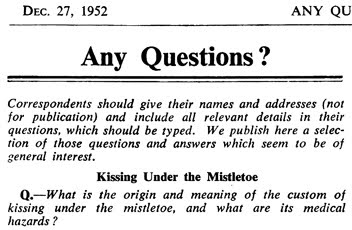Schamberg's Well-Known Kissing Party: Mistletoe, syphilis, and other holiday hazards
by Matt Herbison
During the 1920s and 1930s, 4th Year students of Woman's Medical College (WMC)
were required to write a thesis for their Hygiene and Preventative Medicine
class. I've been looking at some patterns running through these theses and
found that between 1928 and 1932, six WMC students wrote papers focusing on
the different aspects of syphilis.

A line in one of these syphilis theses caught my eye and intrigued me. Student
Adele Cohn's 1931 paper makes a reference to "Schamberg's well-known kissing party."
"Schamberg's well-known kissing party" is a phrase chosen by Adele Cohn as a
reference to Jay F. Schamberg's 1911 article "An Epidemic of Chancre of the
Lip from Kissing" (Journal of the American Medical Association, Vol.
57 p. 783, September 2, 1911). Jay F. Schamberg, M.D., was Professor of
Diseases of the Skin at the
Philadelphia Polyclinic and College for Graduates in Medicine.
A good summary of Schamberg's "kissing party" article is found in a 1930
article on syphilis by Marion Craig Potter:
"The most common of all extragenital lesions are on the lips, from the use
of common cups, the interchange of cigarettes, and kissing. Schamberg
reports an epidemic of chancres from kissing following a Christmas mistletoe
party. 'The source was a young man who had a chancre of the lip. Six young
women kissed by him developed chancres on the lip. Another young man
developed a chancre on the lip, apparently, from the virus deposited on the
lip of one of the young women. In addition, a young woman who was kissed by
the offender at a third social affair was inoculated, making, in all, eight
labial chancres from one source; and later Schamberg was consulted by
another girl who had acquired a chancre of the cheek from a kiss from one of
the aforementioned young women.' Many babies in the cradle are infected in
this manner. Kissing is dangerous!"
(from "Venereal Diseases: Part I: Syphilis" by Marion Craig Potter,
The American Journal of Nursing, Vol. 30, No. 2, Feb 1930, pp.
155-160)
While Marion Craig Potter concludes that "kissing is dangerous" and Adele Cohn
chooses the wonderful phrase "Schamberg's well-known kissing party," they are
not alone in their appreciation for the case study. Another source mentions
that "The kissing party reported by Schamberg has become classic" (see
Preventive Medicine and Hygiene, 4th ed., edited by Milton J.
Rosenau, 1921 p. 61).
The particulars of kissing under the mistletoe are described in detail in
Brewer's Dictionary of Phrase & Fable: "The correct procedure, now rarely observed, is that as the young man
kisses a girl under the mistletoe he should pluck a berry, and that when the
last berry is gone there should be no more kissing." I haven't yet found any
discussions of this berry-limiting, portion-controlled approach to minimizing
disease transmission, but it may be an area ready for research.

I did find further discussion of mistletoe-related infections in a 1952
feature called "Any Questions?" in the The
British Medical Journal (BMJ, Vol. 2, No. 4799, Dec. 27,
1952, pp. 1431-1432). After a discussion of technique, comparing the "dutiful or chaste kiss" to
the "full-blooded passionate kiss," the author moves on to the topic of
infection transmission.
In regard to spreading syphilis through kissing, "certain very delicate
micro-organisms ... can certainly be transmitted directly, notably those of
Vincent's infection [aka "trench mouth"] and syphilis." The author does put
things in perspective, saying that many mouth-bourne bacteria have no problem
living outside the mouth, therefore "it is of course worse to be sneezed or
coughed at, and the probability is ... that a kiss would be preferable to
either of these experiences."
It goes on to warn, "Don't assume you know where your family members' lips
have been" (my paraphrasing). The author then follows through on this familial
warning with a tongue-in-cheek, washing-my-hands-of-the-situation comment:
"This discordant and unpleasant note is introduced only for the sake of
scientific completeness." Right.
But there's more to holiday parties than extragenital disease transmission.
Seasonal social gatherings are beset with unforeseen physiological mechanisms
and their repurcusions. This section in BMJ includes a Q&A; for
other holiday hazards, including:
-
Does mulled claret and punch make you drunk faster if it is served hot or
cold?
- What are the botulism risks of imported canned meat?
- Should a bowel purgative be used after a heavy Christmas dinner?
- What are the poisoning risks for holly and mistletoe berries?
-
Will one's drunkenness feel worse after a person ventures out into the cold?
- How does one sterilize his or her bagpipes?
- What are the risks of handling radioactive isotopes?
I don't know about that last question, but evidence suggests that the holidays
are a bloody minefield.
I have a yearly ritual -- as soon as Thanksgiving is over, I start listening
to Christmas music. Since starting this research, all I now hear are
clandestine death threats. Whether it's Burl Ives trying to poison me with his
"Holly Jolly Christmas" or Andy Williams wishing me lip sores and an
unspecified cardiac condition: "There'll be much mistletoe-ing / And hearts
will be glowing." Maybe Andy is trying to warn us, I can't tell. And a montage
from some sort of Martin Scorsese film reels through my head when I hear Frank
Sinatra insinuate: "Oh, by gosh, by golly. It's time for mistletoe and holly.
Fancy ties an' granny's pies, an' folks stealin' a kiss or two. As they
whisper, Merry Christmas to you." I'm starting to think that Grandma had it
lucky when she got run over by that reindeer. At least she went quickly.
So, from the safety of my basement archives bunker, I wish everyone a Happy
Holiday Season. I'm still deciding whether to light a candle or curse the
darkness, but either way I hope to see you in the New Year.